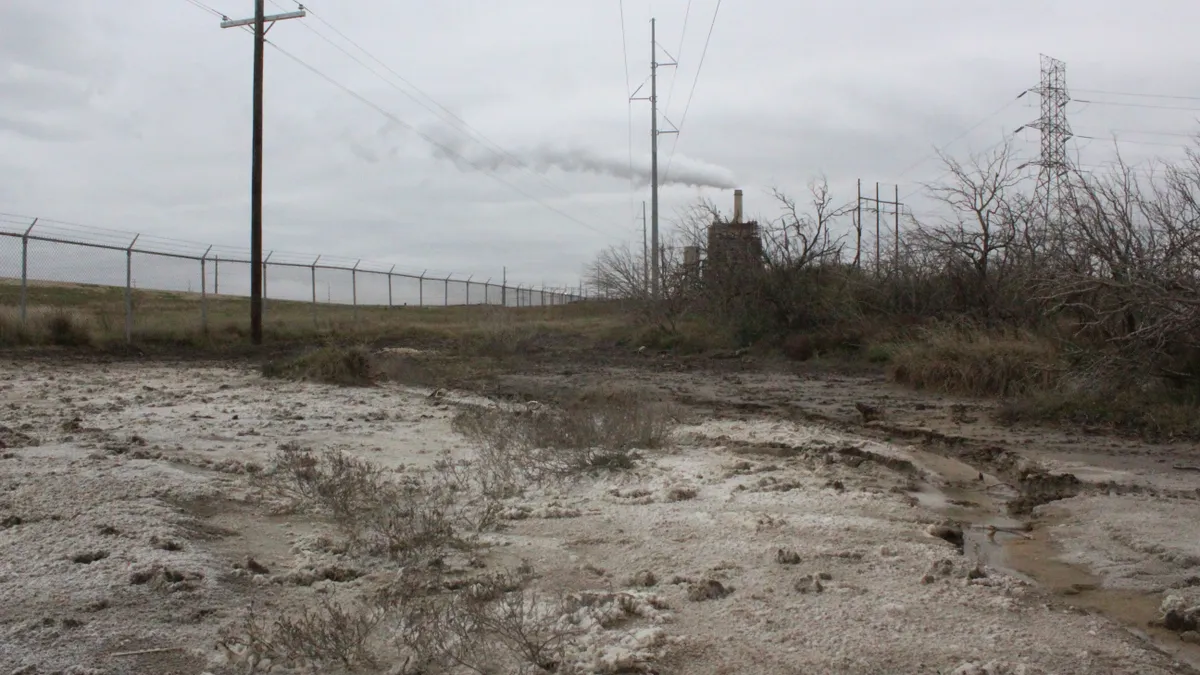Dive Brief:
-
Coal ash may present an increasingly complicated and controversial problem for utilities, regulators and ratepayers as tensions rise over the environmental impacts of the waste stream and federal regulations remain in flux, according to a new report.
-
An estimated 110 million tons of coal ash are disposed of annually in the U.S., and though a rising portion of that waste is being recycled, many utilities are missing out on the opportunity to recycle the ash or put it to beneficial use, the National Association of Regulatory Utility Commissioners (NARUC) found in its January report.
-
That waste stream could prove beneficial to the U.S. if optimized, according to the report's authors, including as a potential domestic supply chain for materials needed in construction and vehicle manufacturing.
Dive Insight:
Tensions between environmentalists and utilities over coal ash regulations have risen in recent years as the Trump administration continues to weaken federal rules set under the Obama administration. Amid federal uncertainty, North Carolina and Virginia in 2019 set aggressive clean up timelines for utilities to excavate their coal ash ponds.
Those states as well as the Tennessee Valley Authority have all been "early movers" in terms of being forced to take action on coal ash management, report co-author and Executive Director of CRISIS and Energy Markets Ken Malloy told Utility Dive in an email.
"If these three leading situations resulted in intense scrutiny it is not a leap to expect that other states will eventually receive similar scrutiny," he said, particularly as parts of the federal rule remain in flux under a D.C. Circuit Court of Appeals ruling, which found the Obama-era rules didn't go far enough in protecting public health and the environment.
Under this atmosphere, cost remains the biggest concern for regulators and utilities as pressure mounts for action. In Georgia, for example, regulators approved an almost $2 billion rate hike, with the vast majority of the increase going toward coal ash clean up costs, according to the Public Service Commission.
Cost is ultimately the biggest concern for most regulators, Alabama PSC Commissioner Jeremy Oden told Utility Dive in an email.
"I have to make the decision that will least impact the rate payer," he said.
The cheapest disposal option in many places is to leave the ash in place and put a cap over the top. But there are outlying concerns at many basins where either the bottom of the facility was not built with a liner in place, or that liner has worn down from years of use.
This poses a risk that the watered down ash, which contains heavy metals and toxins related to a range of health effects, could leach into surrounding groundwater or waterways, which is why most environmentalists prefer complete excavation.
"A majority [of coal ash facilities] are over 40 years old, with the oldest impoundment recorded by EPA, having been constructed in 1925, and now being almost 95 years old," according to the NARUC report. "Many of the older impoundments were also not designed by professional engineers. The question of their structural integrity is critical because surface impoundments are generally located adjacent to surface water."
But the debate between cap in place and full excavation is in many ways shortsighted, and ignores the potential of beneficial use, report co-author and energy consultant Maria Seidler told Utility Dive in an email.
"You won't see in the closure plans filed non-conventional designs, approaches, technology that can offer the environmental security of excavate and haul but at lesser costs. But they are out there," she said. "This myopic approach is why our disposal policies treat beneficial use as a side conversation, instead of a core economic and resource objective, which it could be under a warehouse or inventory strategy for coal ash supplies."
Beneficial use of coal ash has seen a steady rise, likely — 64% of ash was recycled in 2017, according to the American Coal Ash Association. The waste industry has been a leader in disposal and management tactics, noted Seidler, and her number one recommendation to utility regulators would be to find incentives for utilities to put that waste to beneficial use and try to spur a stronger market for it.
Cenospheres in particular present an opportunity for beneficial use in the U.S., Seidler said during the webinar, particularly as federal agencies worry about long-term reliance on rare earth mineral imports. The light, hollow spheres are being considered as a potential tool to build electric vehicle batteries — making them lighter and therefore able to travel longer distances, she noted.
The Department of Energy is looking "at other uses for coal, things like rare earth elements, critical minerals that can be developed and extracted from coal residue," Energy Secretary Dan Brouillette told reporters on Friday. "So in my personal view there's still a bright future for coal, and we just have to continue to develop it."
Waste companies, for their part, are anticipating a major market opportunity.
"[T]here are 700 active and inactive ash pods in the United States that are covered by state and federal CCR regulations. And so over the next probably decade, those electric utilities are going to have to address somewhat in the neighborhood of 700 million tons," Waste Management President, Director and CEO James Fish said during the company's Q2 earnings call in 2019.
"It's a big, big number, and we certainly believe we'll get some portion of that based on past history."
Iulia Gheorghiu contributed to this reporting.















